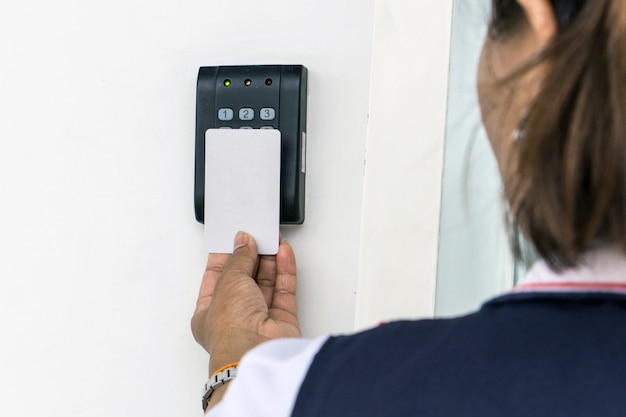Access control systems serve as a sophisticated first line of defense, permitting authorized entry while screening out threats. By integrating layered identity verification—including credentials like badges, PINs, and biometrics paired with surveillance technology—these intelligent systems determine permission for physical access.
Schools and corporations alike rely on access control’s discerning capabilities governing carefully who passes through entry points. The most robust enterprises leverage multi-factor authentication with devices evaluating fingerprints, retina scans, and more before granting access to sensitive areas.
Factor in AI-powered analytics learning along the way, and a cutting-edge access control system literally thinks on its feet, keeping danger at bay. Though we may take their seamless security for granted, these gatekeepers operate 24/7 to protect our most valued assets behind the scenes. When balancing convenience, safety, and privacy is paramount, access control provides an advanced solution to the task.
How Access Control Works
Access control systems require people to authenticate their identity before allowing entry. Individuals must verify who they are through credentials like keycards, passwords, PINs, or biometrics such as fingerprints or retina scans.
Many systems also incorporate surveillance cameras, alarms, and sensors on doors and other entry points to provide multilayered protection. Sophisticated software ties everything together, enabling features like scheduled or remote locking/unlocking and detailed activity reports.
Types Of Access Control Solutions
From small offices to multinational companies, there’s a form of access control for every need and budget. Card-based systems requiring an authorized badge for building entry are common. However, not every company needs biometric systems to confirm identity via fingerprints or other unique physical identifiers before granting access and offering a high level of security.
Internet-based systems allow convenient remote functionality through web applications and mobile device control. Whatever the technology, there are now more access control options than ever protecting facilities worldwide.
Furthermore, the security access control solutions can be divided into different sections, and they include visionary access control, role-based access control, and mandatory access control. The manufacturers of these access control systems are evolving with continuous ideas.
They are working on extensive permutations and combinations with the technology, improving the overall security system. Hence, standardized security is the ultimate objective that the stakeholders are looking at.
Benefits For Buildings Big And Small
An electronic access control system can benefit anywhere managing access is a priority. For large corporations, it boosts security while making it convenient for thousands of employees to move freely within appropriate areas. Schools utilize the technology to screen visitors while tailoring access permissions so staff, students, and parents only reach certain locations.
Government and healthcare facilities house sensitive information, making rigorous access regulation essential. Even small businesses stand to gain from streamlined access management, employee accountability, and strengthened protection.
The Use Of Access Control Systems In Diverse Sectors
Access control systems simplify the entire security network in different ways. Whatever your business may be, you make use of them here for the sake of your convenience. However, a wide range of industries use access control systems.
Business Enterprise
Any business that accepts and thereafter processes the credit cards must meet the data regulations. The access control system can restrict the IT rooms. Thus, they can track down access to certain data and thereafter safeguard information.
Healthcar
Healthcare is one of the sectors that is sensitive and vulnerable to the intrusion of outside elements internal to her periphery. The healthcare units use access control systems to adhere to the HIPPA regulations for health data. The insurance companies’ doctor’s offices protect the care users with access to the control systems. They can protect the IT rooms with the equipment. Ultimately, you get the safeguarding with the help of the physical files and highly sensitive equipment like the MRI machines.
Government
Security is one of the topmost priorities of the local and state governments. The buildings of the governments are subject to the security regulations of the homeland. It may restrict the entry. However, access control systems verify employees’ access to confidential information.
Education
Education is one of the important business sectors that take absolute control over their internal system through access control. The schools, colleges, and universities have many campuses which are quite large. Moreover, they have security needs in multiple locations.
The access control systems for the students and the faculty help them enter through the doors and access points on the entire campus. Even the lab equipment or the expensive computers can be programmed. It ensures that only those who are registered for the courses can enter the facility.
Worship Centers
Hundreds and thousands of people attend these places. These spiritual centers welcome people from different places. The access control makes entering the compound easy. The synagogues and the mosques can track the comings and goings of the employees. At the same time, they also keep the areas like daycare centers and offices safe and secure for others.
Bringing Access Control Into The Future
Access control technology continues advancing rapidly, with cutting-edge systems offering more security, functionality, and analytics than ever before. Emerging trends include remote capabilities via cloud platforms, increased automation through artificial intelligence, expanded biometrics identification, and integration with other systems like video surveillance and fire detection.
As risks evolve, so too will access control systems, incorporating innovative resources to keep infrastructure, data, assets, and people better protected worldwide.
Staying One Step Ahead
In a complex world, access control systems deliver an invaluable safeguard to help keep what we care about most a little bit safer. As long as there are threats for soft targets, access control will remain an essential cornerstone in enhancing security in facilities across every landscape. These stalwart protectors stand guard 24/7, vigilantly keeping danger at bay and peace of mind in reach. When so much relies on staying one step ahead of malicious activity, access control systems will continue advancing to meet each emerging challenge.

























